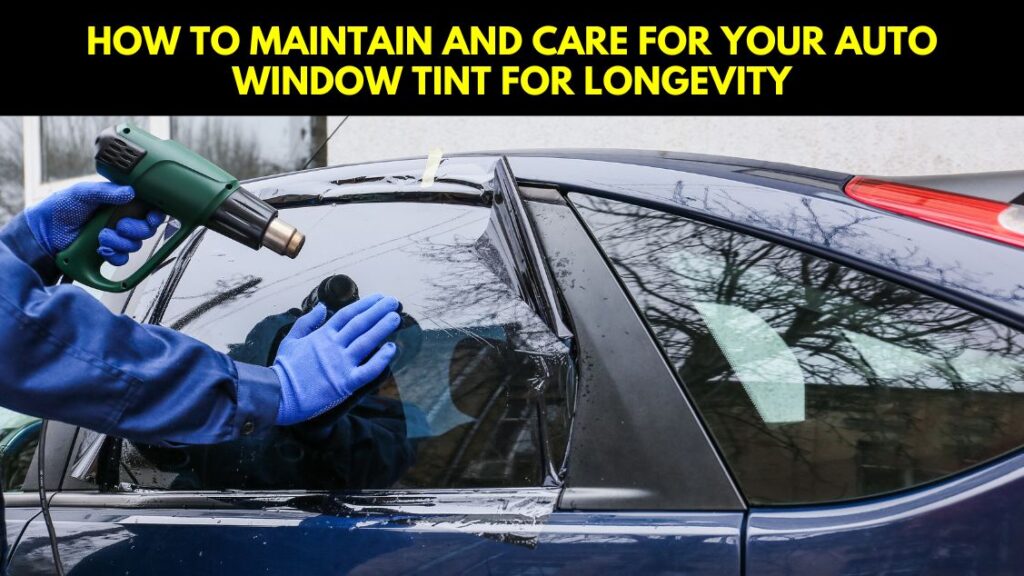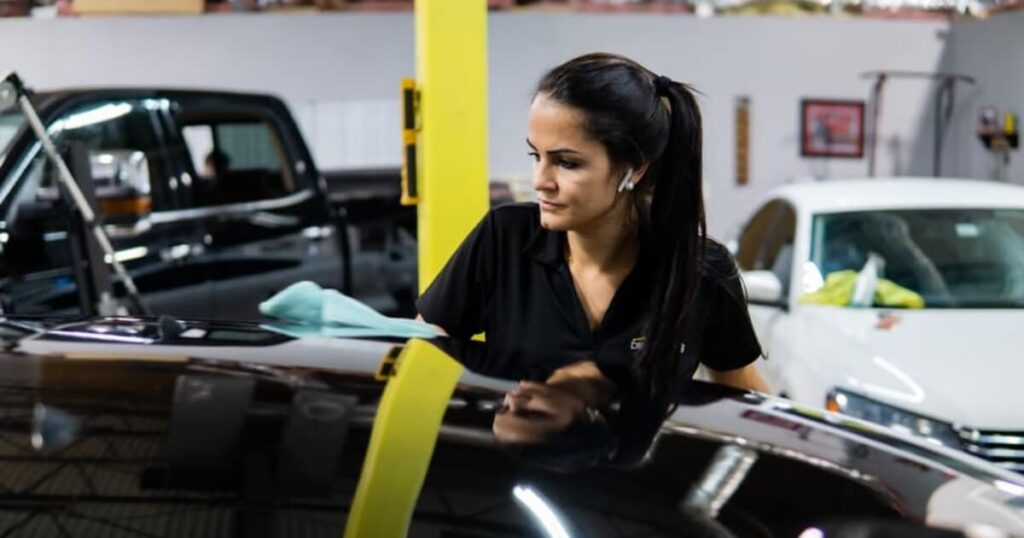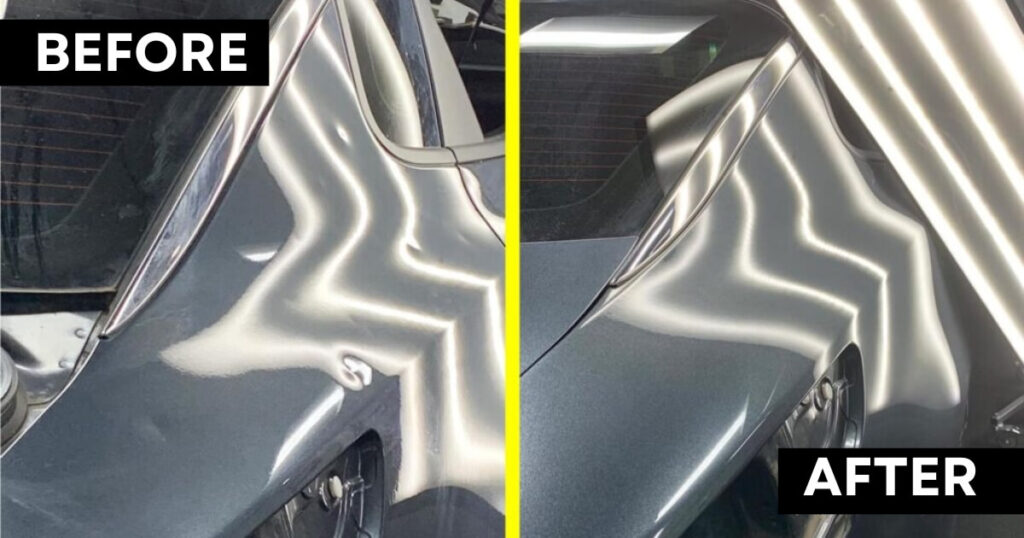Car window tinting not only adds a touch of sophistication to your vehicle but also serves practical purposes such as enhancing privacy and minimizing heat and glare. However, to preserve the sleek appearance and functionality of your tint, adopting proper maintenance practices is essential.
Enhancing security and privacy for both drivers and passengers, window tinting has become a popular choice. A survey conducted by the International Window Film Association revealed that 57% of car owners opt for window tinting primarily for privacy reasons.
While window tinting proves to be a worthwhile investment for vehicle owners, ensuring its prolonged effectiveness requires attention to maintenance. This blog aims to provide comprehensive tips on car window tinting maintenance, guiding you on how to preserve its aesthetic appeal and functionality for an extended period.
Covering aspects such as steering clear of harsh chemicals and employing the right tools and techniques for cleaning, this post serves as your go-to resource for all things related to the proper maintenance of car window tinting.
What is Car Window Tinting?
Car window tinting involves the application of a thin film to a vehicle’s windows, aiming to diminish the penetration of sunlight and heat into the interior. Typically crafted from polyester or other synthetic materials, this film comes in various dark shades. Widely embraced as an aftermarket modification, car window tinting not only enhances a vehicle’s aesthetics but also contributes to its functionality.
A survey conducted by the International Window Film Association sheds light on the motivations behind car owners opting for window tinting. The primary reasons cited include the desire to reduce heat and glare, safeguard the vehicle’s interior, and augment privacy. Notably, 54% of respondents chose window tinting for heat reduction, 45% for glare reduction, and 38% for privacy enhancement, highlighting the multifaceted appeal of this popular vehicular modification.
Car window tinting extends beyond aesthetic enhancements; it offers a range of additional benefits:
UV Protection: Tinting acts as a barrier, blocking up to 99% of harmful UV rays. This not only prevents potential skin damage and the risk of skin cancer but also safeguards the vehicle’s interior from fading over time.
Improved Safety: In the unfortunate event of an accident, window tinting serves as a preventive measure, reducing the risk of shattered glass flying into the car and minimizing the potential for injuries.
Energy Savings: By curbing the influx of heat into the vehicle, window tinting contributes to enhanced fuel efficiency and diminishes the reliance on air conditioning, thereby promoting energy savings.
While car window tinting is generally legal in most states, regulations vary concerning the darkness of the tint and its application on the vehicle. It is crucial to familiarize yourself with local window tint laws before proceeding to avoid any legal complications.
The multifaceted benefits of window tinting are underscored by its increasing popularity. According to a survey conducted by the International Window Film Association, the demand for car window tinting has experienced an annual growth of 7% in recent years. The survey also highlighted that 86% of car owners choose to tint their windows primarily to reduce heat and glare from the sun. This surge in interest solidifies the notion that car window tinting is a valuable investment, offering improvements in comfort, safety, and privacy for vehicle owners.
Advantages of Car Window Tinting Maintenance
Ensuring the upkeep of your car’s window tint is vital for both its visual appeal and optimal functionality. The benefits of maintaining your car’s window tint are diverse, spanning heightened privacy, defense against harmful UV rays, and an uptick in energy efficiency. Nevertheless, it’s prudent to balance these benefits against potential drawbacks, such as maintenance costs and the risk of tinting film damage.
Enhanced Privacy
A primary boon of maintaining your car’s window tint is the bolstering of privacy. Tinted windows act as a shield against prying eyes, particularly advantageous when parking in public spaces.
Glare Reduction
Premium-quality tints contribute to a reduction in glare from the sun and headlights during nighttime driving. This not only enhances visibility but also ensures safer driving conditions.
UV Protection
Proactive maintenance ensures that tinted windows can effectively block up to 99% of harmful UV rays. This not only safeguards against skin damage but also shields the vehicle’s interior from the perils of fading over time.
According to a study conducted by the American Skin Cancer Foundation, standard car windows block only about 53% of harmful UV rays, whereas window tinting can achieve up to 99% UV blockage.
Energy Efficiency
Tinted windows play a crucial role in regulating the car’s internal temperature, reducing the need for excessive air conditioning during the sweltering summer months. This not only enhances energy efficiency but also contributes to a cooler and more comfortable interior.
Disadvantages of Car Window Tinting Maintenance
Cost of Maintenance
Appropriate maintenance may involve periodic replacement of the tinting film, incurring costs. This factor should be considered in the overall investment.
Risk of Damage
Without adequate maintenance, there’s a risk of damage to the tinting film, especially if it gets scratched or scraped. Regular care is essential to mitigate this risk.
Legal Considerations
Laws governing the permissible level of tint on car windows vary by state. It is imperative to check local regulations before installing or maintaining window tinting to ensure compliance.
Tools and Materials Needed for Car Window Tinting Maintenance
Maintaining your car’s window tint is essential to preserve its sleek appearance and functionality. Here’s a guide on the tools and materials needed for effective car window tinting maintenance:
- Soft Microfiber Cloth Towel:
Purpose: Essential for gentle cleaning and maintenance of tinted windows.
Why: Microfiber towels are surface-friendly, ensuring no scratches or residue are left behind.
- Ammonia-Free Glass Cleaner:
Purpose: Necessary for removing dirt, grime, and fingerprints from tinted windows.
Why: Avoid ammonia-based cleaners to prevent damage to the tint.
- Plastic Razor Blade:
Purpose: Valuable for removing stubborn debris and residue from tinted car windows.
Why: Plastic blades are crucial to prevent scratches on the tinted surface.
- Soft-Bristled Brush:
Purpose: Ideal for cleaning edges and corners, removing dirt and debris.
Why: Soft bristles prevent damage to the tint while effectively cleaning hard-to-reach areas.
- Tint Safe Cleaner:
Purpose: Specifically designed to clean and maintain window tint without harsh chemicals.
Why: Ensures gentle care for the tint, prolonging its life without causing damage.
- Water:
Purpose: Plain clean water for cleaning tinted windows.
Why: Use distilled water to prevent mineral deposits on the tinted surface.
- Protective Film:
Purpose: Applied to protect tinted windows from scratches, chips, and damage.
Why: Choose a film designed for window tinting to ensure effective protection.
Using these tools and materials, car owners can guarantee that their window tint films stay clean, clear, and protected. Regular maintenance with these essentials not only preserves the tint’s appearance but also extends its lifespan, ensuring it looks great for years to come.
How to Prepare Your Vehicle for Window Tint Maintenance
Properly preparing your vehicle for window tint maintenance is crucial to ensure the longevity and quality of your window tinting. Following the recommendations of auto glass technicians who provide window tinting services is key to avoiding damage to both the tint and the glass surface.
First and foremost, refrain from using harsh chemicals or abrasive cleaning tools on your window glass. Opt for a mild soap and water solution, applying it with a soft cloth or sponge for a gentle cleaning process.
In addition, it’s important to avoid rolling down your windows for at least 48 hours after the tint application. This precautionary measure helps prevent the formation of air bubbles.
An integral part of effective tint maintenance involves using the correct application tools and techniques to avoid unsightly air bubbles. These bubbles, if left unaddressed, can lead to the peeling of the tint over time, leaving your vehicle’s windows vulnerable.
To prepare your vehicle for window tint maintenance, start by thoroughly cleaning the glass surface to eliminate any accumulated dirt, dust, or debris. Use a soft, lint-free cloth for wiping, steering clear of abrasive cleaners, or tools that may scratch the glass.
Once the glass surface is clean, inspect it for any scratches or chips that may have occurred during installation or regular wear and tear. If any damage is detected, it’s advisable to take your vehicle to a window tinting shop or auto glass technician for repair before proceeding with maintenance.
Next, ensure you have the proper application tools, including a squeegee, spray bottle, and razor blade, to eliminate any air bubbles that may have formed under the tint. Investing in quality tools is essential to achieve an even tint application and prevent air bubbles that could compromise the tinted film’s integrity.
Follow the window tint care instructions provided by your auto glass technician or window tinting shop, ensuring you employ the right techniques and products for your specific type of tint. By meticulously preparing your vehicle for window tint maintenance, you can guarantee that your tint remains in excellent condition for years to come.
Park in Direct Sunlight to Assess Damage/Soiling
Parking your car in direct sunlight serves as an effective method for assessing damage and soiling on car window tint. Any imperfections or damages present on the tinted film become more visible when exposed to sunlight. This is because sunlight has the ability to highlight scratches, bubbles, or peels on the window tint.
Moreover, sunlight can accentuate dirt or grime on the tint, making it more noticeable. By parking the car in direct sunlight, car owners can promptly identify any issues with their window tint and take necessary action, whether it be repair or replacement.
It’s crucial to note, however, that constant exposure to sunlight can also contribute to damage on the tint itself. Car owners should exercise caution and avoid leaving their cars parked in the sun for extended periods to mitigate potential harm to the window tint.
Wash Windows with Warm Water and Soft Cloth or Paper Towel
Effectively removing bird droppings from tinted car windows requires a gentle approach and the right tools. Here’s a step-by-step guide:
- Spray with Tint-Safe Glass Cleaner:
Start by spraying the affected area with a glass cleaner specifically designed for use on tinted windows. This ensures that the cleaner won’t damage the tint.
- Allow Cleaner to Sit:
Let the glass cleaner sit for a few minutes to loosen the bird droppings. This allows the cleaner to penetrate and make the removal process easier.
- Gently Wipe with Microfiber Cloth:
Take a clean microfiber cloth and gently wipe away the bird droppings in a circular motion. Avoid using excessive pressure or abrasive materials that could potentially scratch the tinted surface.
- Repeat or Use Specialized Remover if Needed:
If the bird droppings are particularly stubborn, you may need to repeat the process. Alternatively, you can use a specialized bird-dropping remover for more effective removal.
- Dry and Polish:
Once the droppings are removed, dry and polish the area to a streak-free shine using a clean microfiber cloth. This step ensures a clean and polished finish on the tinted window.
Regularly cleaning bird droppings from tinted car windows is essential to prevent potential damage and maintain the overall appearance of your vehicle. By following these steps and using the appropriate tools, you can effectively and safely remove bird droppings without compromising the integrity of the tinted surface.
How to Wash Tinted Windows?
Here’s a step-by-step instruction for washing tinted windows with warm water and a soft cloth or paper towel:
- Gather Materials:
Collect all necessary materials, including warm water, a soft cloth or paper towel, and a bucket if needed.
- Fill Bucket with Warm Water:
Fill the bucket with warm water, ensuring it’s not too hot as hot water can potentially damage the tint on the windows.
- Dampen Cloth or Paper Towel:
Dip the soft cloth or paper towel into the warm water, wringing out any excess water so it’s damp but not dripping wet.
- Wipe Vertically from Top to Bottom:
Starting from the top, gently wipe the tinted surface vertically to remove dirt or grime.
- Use Clean Sections for Each Swipe:
Utilize a clean section of the cloth or paper towel for each swipe to prevent spreading dirt and debris.
- Treat Stubborn Spots with Gentle Cleaner:
If there are stubborn spots or stains, use a gentle cleaner designed explicitly for tinted windows. Apply it to the affected area with a soft cloth or paper towel.
- Rinse with Clean Warm Water:
Rinse the glass surface with clean warm water to remove any soap or cleaner residue.
- Dry to Avoid Water Spots:
Dry the glass with a clean cloth or paper towel to prevent water spots.
- Repeat for Each Window:
Repeat the process for each window on the car until all tinted surfaces are clean and free of dirt and debris.
- Dispose of Used Materials:
Properly dispose of any used materials, and enjoy the clean and clear view through your freshly washed tinted windows.
What Should Be Avoid with Auto Window Tinting?
Auto window tinting is a popular enhancement for both appearance and functionality, but certain practices should be avoided to ensure a successful process and prevent damage to your vehicle.
Avoid Low-Quality Materials
Steering clear of low-quality tinting materials is crucial. Subpar tinting can lead to issues like bubbling, peeling, and discoloration, reducing the lifespan of your tint.
Avoid DIY Car Tinting
DIY tinting, while tempting, can result in uneven coverage or damage to your windows. Professionally done tinting ensures a better outcome and avoids costly repairs.
Avoid Choosing Excessively Dark Shades
Opting for a tint shade that is excessively dark can lead to legal issues in some states and compromise safety on the road. Dark tints reduce visibility, particularly at night, and can be hazardous.
Choose Legal Auto Tinting Shades
Ensure the tinting shade adheres to legal limits in your state, promoting adequate visibility and road safety. Dark tints may hinder law enforcement visibility, posing a safety concern.
Avoid Incompatible Auto Tinting Materials
Selecting a tinting material that is incompatible with your car’s windows or climate conditions can result in poor performance and reduced effectiveness.
Apply Tinting to Clean Windows
Avoid applying tinting to dirty or damaged windows. Clean windows provide a better surface for tint adhesion and longevity.
Avoid Cleaning with Abrasive Products
Refrain from using abrasive products, tools, or ammonia-based cleaners on tinted windshields and glass. These can damage the tint and reduce its lifespan.
Avoid Steam Cleaning and Razor Blades
Steam cleaning and using razor blades on tinted windows can cause damage. Stick to gentle cleaning methods to preserve the integrity of the tint.
Don’t Roll Down Windows Before Full Cure
Refrain from rolling down windows before the tinting has fully cured. Premature contact can affect the adhesion and quality of the tint.
Address Signs of Damage Promptly
Avoid ignoring signs of damage or wear on your tinting. Timely attention to issues ensures the tint’s effectiveness and prolongs its lifespan.
By avoiding these common pitfalls, you can ensure a successful and long-lasting auto window tinting experience for your vehicle.
Should I Wax My Car Windows to Maintain the Tinting Film?
Waxing car windows is a common practice among car enthusiasts to maintain the shine and cleanliness of their car’s exterior. However, many people wonder if waxing the windows is safe and beneficial when it comes to cars with window tinting film.
Here are some pros and cons to consider before deciding whether to wax your car windows with tinting film:
Pros:
1. Protection: Waxing your car windows can provide extra protection against environmental factors like rain, snow, and UV rays. This can help prolong the life of your window tinting film and keep it looking new for longer.
2. Easy Cleaning: Waxing can make cleaning your car windows easier by repelling dirt and water. This can save you time and effort in maintaining your car’s appearance.
3. Enhanced Appearance: Waxing can add a glossy shine to your car’s windows, enhancing its overall appearance and making it stand out on the road.
Cons:
1. Damage to Tinting Film: Waxing your car windows with tinting film can potentially cause damage if not done correctly. The wax can seep into the edges of the film and cause it to peel or bubble, which can ruin the appearance of your car’s windows.
2. Voided Warranty: Some tinting film manufacturer may void the warranty if the windows are waxed or treated with other chemicals. This can leave you with costly repairs if the film needs to be replaced.
3. Safety Concerns: Waxing your car windows can make them more slippery, reducing visibility and posing a safety hazard while driving.
Conclusion
In conclusion, proper maintenance is crucial for the longevity and functionality of your auto window tint. From selecting the right cleaning tools to avoiding common pitfalls, following these tips ensures a lasting and appealing tint. Consider Dentwerks Pro for the best auto window tint services and expert care in Dallas and surrounding areas of Texas. Their skilled technicians prioritize quality installations and provide guidance on maintenance practices. Trust Dentwerks Pro for sleek and well-maintained window tinting, ensuring your vehicle looks its best for years to come.



